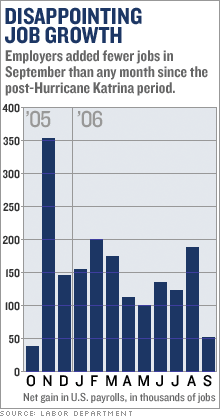Job growth slows September job gain far less than expected, but unemployment improves to 4.6 percent; wage gain also less than forecast. NEW YORK (CNNMoney.com) -- Job growth in September slumped to levels not seen since the post-Hurricane Katrina period, as the government's latest reading on the job market set off alarms in the stock market. Overall, U.S. payrolls grew by only 51,000 jobs in September, according to the Labor Department. That's down from the revised 188,000-job gain in August and is the smallest gain since October 2005. Economists surveyed by Briefing.com had forecast a gain of 120,000 jobs.
The report included a larger than normal revision of the August number, which was originally reported as a 128,000-job gain. The extra 60,000 jobs added that month, when coupled with the weak gain reported for September, was close to the forecasts. And with the revisions, job growth over the past 12 months now stands at a solid 1.8 million. The unemployment rate improved to 4.6 percent in the month. Economists had forecast that the rate would stay at the 4.7 percent level reported for August. The unemployment rate is based on a survey of households rather the employer survey used to calculate the payroll number. While the employer survey is generally seen as more accurate, the household survey was very positive, showing a robust 271,000-job gain, and a 170,000 decrease in the number of unemployed people. Still, even with the larger revision in August job growth and the strong results from the household survey, investors appeared worried by the report. Stocks, which have been on a rally that produced three straight days of record highs for the Dow, were down in morning trading on the report. John Silvia, chief economist with Wachovia, said the report raises more questions than it answers, which can pose problems for markets. "Is September the aberration, or is September the month we fell off the cliff?" he asked. "I hate to say, but we really don't know until we see the next report." Average hourly wages were up 4 cents, or 0.2 percent, to $16.84. That was less than the 0.3 percent rise forecast by economists. Manufacturers cut 19,000 jobs from the sector. That's in line with other readings, such as the Institute of Supply Management's survey of manufacturing executives, which in September showed more companies cutting than adding staff. But one sector hit by high-profile cuts, automakers and auto parts companies, actually showed a 1,700 increase in jobs in the report. And Ford Motor (Charts) and DaimlerChrysler (Charts) are slashing fourth-quarter production because of weak sales. General Motors (Charts) and Ford are moving ahead with plans to cut staff and close plants. But Asian-based automakers are increasing their North American production, helping to support the sector's job base. Toyota Motor (Charts) is preparing to start production at a new plant in San Antonio soon. And GM has been replacing some of its recently retired employees with new, lower-paid employees. One sector that again showed disappointing jobs numbers was retail, where employers trimmed 12,000 jobs from payrolls in the month, according to the report. The latest cut left retail employment off 116,200 from the August 2005 levels, after which the sector took a hit from store closings caused by Hurricane Katrina. Another battered sector that appeared to show surprising strength at first blush was construction, which added 8,000 employees despite a sharp downturn in new home sales and housing starts in recent months. But the gain in construction was from nonresidential construction. Residential construction firms and specialty contractors in the field, such as electricians and carpenters, had a net drop of 15,600 jobs. The weak retail employment number came even though retailers generally reported sizzling September sales in reports released Thursday. Economists have suggested that part of the problem with retail employment is that retailers are making changes in recent years to more closely track customer flows and are keeping their staffing levels more closely tied to those readings. There has also been a series of mergers within the retail industry in the past 18 months, some of which are only now resulting in store closings and cuts in corporate support staffs. Within the past 18 months, for example, Kmart purchased Sears Roebuck to form Sears Holding (Charts); May Department Stores Company was acquired by Federated Department Stores (Charts); Albertson's, then the nation's No. 2 grocer, was purchased by a group that included another competitor Supervalu and drugstore chain CVS. And No. 3 drugstore chain Rite-Aid is in the process of buying the Brooks Eckerd drugstore chain. Still some economists pointed to the continued weak retail employment and the disappointing job growth overall as signs of a slowing economy going into the fourth quarter. "Although many are forecasting a boom in retail sales that is capable of boosting consumer spending, it sure doesn't feel that way when one looks at the recent trend in retail hiring," said Anthony Chan, chief economist for JPMorgan Private Client Services. |
| ||||||||||||||

